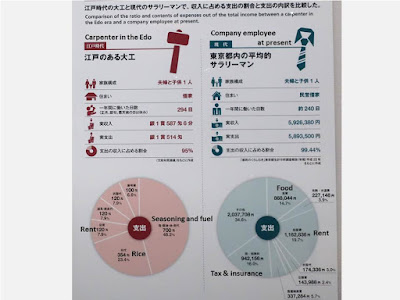大規模改修のため、2025年まで休館です。再開が楽しみですね。
Recent info. 最新情報:江戸東京博物館 (edo-tokyo-museum.or.jp))
You can understand most about
Edo (old name of Tokyo, before 1867) and Tokyo in this huge museum. I focus on the Edo period here. Various enjoyments are exhibited such as festivals,
theaters, reading and red light district Yoshihara, meanwhile difficulties in
life are also exhibited.
江戸、東京の全てが分かる巨大博物館である。ここでは、江戸時代を中心に記載した。人の楽しみの面からみると、読書、縁日、芝居、吉原などの人の楽しみ、また、苦しみも詰まっている。
Inside the entrance gate, there is a
full-scale model of Nihonbashi Bridge. On the other side of the bridge, samurai’s
life is exhibited. On the bridge, we can see a model of Kabuki theater in the Edo period
on the left and Tokyo city in the Meiji period on the right.
エントランスを入ると実物大の日本橋がある。橋の正面は、徳川家をはじめ武家の暮らしを展示するエリア。橋の左側は江戸庶民の暮らしを展示するエリア。歌舞伎の芝居小屋がある。橋の右側は、明治以降、東京の展示となっている。
 |
| Model of Nihonbashi bridge、日本橋の実物大模型 |
 |
| Left side of the bridge : Edo zone、橋左の江戸ゾーン |
 |
| Right side of the bridge : Tokyo zone、橋右の東京ゾーン |
【Edo Castle and the District Zones】
 |
| Model of the Edo castle which is Imperial Palace now 江戸城の模型 |
 |
| Model of the Edo castle from the opposite side 本丸側から見た江戸城の模型 |
 |
| Plain figure of the Edo castle、江戸城地図 |
 |
| Model of Dimyo’s mansion in Edo city 松平伊予守(1597-1645)の大名屋敷 |
 |
| Women’s palanquin which may have belonged to birth mother of the 13th shogun、13代将軍家定の生母のものと思われる女乗り物 |
 |
| Palanquin for ordinary people 庶民用の駕籠(竿は短め)@草津宿街道交流館 |
 |
| Exhibits about shogun and daimyo、武家に関する展示 |
Beautiful
utensils for daimyo families including shogun family.
美しい大名道具の数々。
 |
| Vanity box stand which was owned by princess Kazunomiya. 和宮様所用の化粧道具の台(櫛台) |
 |
| Cosmetic box for eyebrow-trimming tools、眉作箱 |
 |
| Basin used mainly for women’s teeth-blackening お歯黒の道具、耳盥 |
【Life of the Townspeople】
We can
see the full-scale model of the apartment house here. Everyday life at that time is
exhibited.
続いて、江戸の長屋を再現したエリアに降りてくる。
 |
| Basic structure of the Edo town、江戸の町の基本構造 |
 |
| Caretakers in the administration office or guardhouse 自身番屋 |
Outline
of the people’s life in Edo is exhibited.
江戸の人々とその暮らし
 |
| Population percentage in the Edo period 江戸時代の人口構成 |
 |
| Family and age structure、家族構成と年齢構成 |
 |
| The lives of people in Edo、江戸町人の人生 |
 |
| Annual and seasonal events of Edo people 江戸町人の一年 |
Life in Edo, old Tokyo (published in 1959)江戸生活事典 Chapter 7: Daily lives 7章をご参照ください。
 |
| Income and expense comparison, now and then 江戸の大工と東京のサラリーマンの収支比較 |
 |
| Everyday meal 日常の膳、質素だが思ったより良い食事だ |
 |
Ranking of the recipes of everyday simple meals
倹約料理の番付、日用倹約料理仕方相撲番付
|
 |
| Ranking of the restaurants in Edo、番付表:流行料理献立競、江戸の人気レストランのリスト(1854) |
The picture below shows how to use fabric effectively. It was used as kimono clothes at first, then it was remade to clothes for children or elderly people, and it was changed to dusters. It was used as fertilizer finally. The mind of reuse is a good Japanese custom and it is known as “Mottainai sprit” (http://www.greenbeltmovement.org/what-we-do/advocacy/mottainai-campaign).
江戸時代、布地は大切だった。仕立て直したり雑巾にしたり、肥料になるまで使う。
Printing
and Reading
This is “Abundance
of printed materials” area. It was written on the caption that literary works,
maps, lists of famous samurais, lists of famous citizens and Yoshihara guide were popular. The
fryers prevailed in the end of the Edo period which were information sources
for people. The number of the book wholesalers was more than 200 and the number of the rental
libraries was 655 in the late Edo period.
「あふれる出版物」というコーナーがあった。
南総里見八犬伝のような文学作品をはじめ、実用的な江戸図、武鑑、町鑑や吉原細見もよく売れた、とある。ペリー来航以来は瓦版などの刷り物が増え、庶民の情報源になったようだ。江戸後期で書物問屋が200軒余り、貸本屋が655人と書かれている。
The book below (published in 1775) is similar to the paperback which included puns and humor. This kind of books is called Kibyoushi book and the title is “Kinbe’s fantastic dream” in which Mr. Kinbe becomes a rich man in his dreams and becomes a frequenter of Yoshiwara and Fukagawa pleasure quarters. He seems to enjoy the party with girls with a massage.
 |
| The location of book wholesalers 江戸市中の書物問屋の分布 |
The book below (published in 1775) is similar to the paperback which included puns and humor. This kind of books is called Kibyoushi book and the title is “Kinbe’s fantastic dream” in which Mr. Kinbe becomes a rich man in his dreams and becomes a frequenter of Yoshiwara and Fukagawa pleasure quarters. He seems to enjoy the party with girls with a massage.
洒落や滑稽を盛り込んだ庶民向けの黄表紙。その始まりといわれている1775年に刊行された恋川春町の「金々先生栄花夢」が展示されている。金々先生こと金兵衛が夢の中で金持ちになり、吉原や深川で遊客となる様子を書いている。按摩を受けながら宴会を楽しんでいるところだ。
 |
| Enjiro’s funny way to be a handsome man (published in 1785)、山東京伝「江戸生まれ艶気のかば焼き」 |
The
photo below shows the seller of Kawara-ban which is an information paper. Some political
topics were banned by the shogunate, so sellers hid faces.
The caption was
written "after the earthquake, numerous woodblock prints featuring a giant
catfish monster circulated throughout the city of Edo. People at that time
believed that a huge catfish that lived underground caused earthquakes.” The
picture below is one of the popular pictures which was published in 1855. It is
humorous.
【Commerce of Edo】
Ships, stands and shops are exhibited here.
続いて、江戸の商業のコーナーとなる。物資の搬送に使われた船や屋台、商店が展示されている。
 |
| Stands in the night festival、東都名所 高輪二十六夜待遊興の図からにぎわう街と屋台 |
There
were many big merchants in the Edo period. The paper below is the list of big
merchants. People liked to rank up even at that time.
諸国家業自慢番付(江戸後期)、右上から鴻池、三井、天王寺屋の文字が見える。番付が好きだ。
The shop
below is a model of a listed cloth shop Mitsui Echigo-ya which was the origin of
Mitsukoshi department store.
大店、呉服店の三井の模型。店内までよくできている。
One of
the employees of Mitsui is shown below. He came to Edo and started working at 13 years old. Later, he
became an executive officer, but he was only allowed to get marriage at 42
years old. It was too late!
Reference :
6 funs(楽Fun) were found in part 1. Visited in October, 2018
https://www.edo-tokyo-museum.or.jp/en/
(English)
https://www.edo-tokyo-museum.or.jp/
(Japanese), accessed in November 2018
Previous post (Samurai HQ = Former Edo
castle & museum) :
Next post (Edo&Tokyo after Medieval 江戸博) :















Comments
Post a Comment